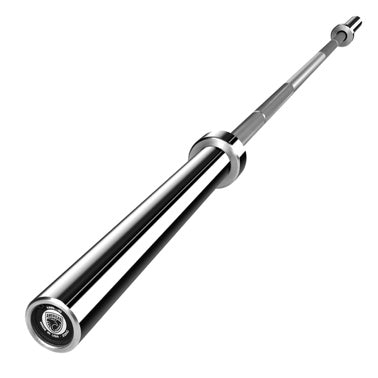THE ANATOMY OF AN OLYMPIC BAR
Shaft Material
For any workout bar, Olympic or powerlifting the material must be very strong but also ductile. High ductility is the crucial component that ensures a workout bar will maintain its straightness during repeated heavy lifting, and it should not be brittle which can lead to sudden failure or breaking. Many high-strength steels though strong are not suitable for lifting bars based on their lack of ductility. When you hear the term “tensile strength” this refers to the limit of force per square inch a workout bar can endure before breaking. “Yield strength” refers to the force a workout bar can endure before permanently bending or deviating from its original straightness. Whether using alloy or stainless steel these guidelines must be strictly followed.
Understanding Tensile and Yield Strength
With any material, whether high strength or not, tensile and yield strengths fluctuate from manufacturing. Steel mills have targets of minimum tensile and yield strengths that must be met each time a heat or run is produced, meaning that the material must never fall below the stated numbers, but can and will be above after production. Any workout bar that is above 180,000 PSI tensile strength begins to loose elasticity and becomes very stiff. Olympic lifters prefer a workout bar with good elasticity (whip) during lifting, whereas a powerlifter prefers a much stiffer workout bar. Many companies quote strengths above 200,000 PSI tensile which is very stiff and therefore not desirable for Olympic lifts.
Sleeves and Material
The ultimate finish is a sleeve with a heavy hard chrome overlay. With this you get a very hard outer shell for protection, as bumper plate hubs can range in hardness and easily damage the sleeves from constant dropping. Again, decorative chrome is the least desirable choice because of the danger from cracking and peeling.
Bar Shaft Finishes
Decorative Chrome
Although used by many companies in the past and today—is a finish not desirable as its primary purpose is for decoration as its name implies. It is not suitable for a workout bar subjected to constant flexing which causes this finish to crack and peel over time which can be extremely dangerous.
Zinc
A plating process with moderate corrosion resistance, but can wear over time, compared to other finishes.

Hard Chrome
A plating process pioneered in the late 1990s by American Barbell exclusively on Olympic bars. This method of chrome not only appeals cosmetically but also eliminates the associated dangers of cracking and peeling. Hard Chrome is not very corrosion resistant but is much safer if all related processes are strictly followed. Hard Chrome is a very thin and hard surface treatment used primarily in the aircraft and automotive industry—usually in oil bathed applications.
Stainless Steel
An obvious choice for corrosion resistance but cost prohibitive for most. It is also a difficult material to machine without the correct composition or heat treatment. The advantages if designed and used correctly are better corrosion resistance over hard chrome, Zinc or other similar finishes, and the ability to mechanically or manually clean the workout bar without impairing the outer surface. It is important to note that stainless steel can rust in extremely humid or salty environments but as discussed may be cleaned by any individual. Expertise is not required.


Cerakote
First introduced by American Barbell. It is a ceramic finish providing unrivaled corrosion resistance as long as the surface is not broken from damage. This damage can be a result of the bar coming in contact with any metal objects such as raw steel gun racks, J-hooks or any other metal.
